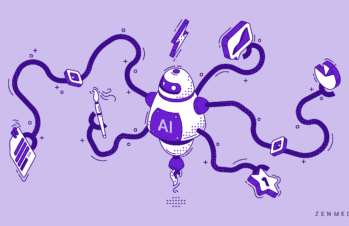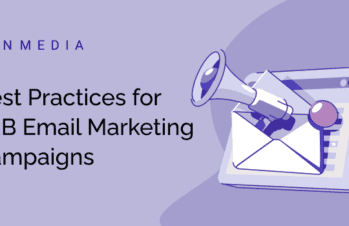Whether you use Hubspot, Mailchimp, Salesforce’s Pardot, or one of the other email marketing platforms out there, at least one universal truth remains: Email marketing automation is only as good as the humans mapping out your email marketing campaign and aligning it with your customer’s journey.
And when done right, automation can be a powerful tool for B2B marketers looking to generate leads, keep customers engaged, and drive real business results.
In this guide, we’ll explore the importance of creating valuable content, building a strong B2B email marketing strategy, aligning with your customer needs, finding the right email marketing platforms for your needs, and measuring and driving success.
Why Email Marketing Automation Matters for B2B
B2B sales cycles are notoriously complex, with longer decision-making processes that last an average of 11 months, and multiple stakeholders involved. In this context, email marketing automation becomes invaluable for its ability to maintain consistent, personalized communication with prospects over the long haul.
Email automation streamlines lead nurturing by delivering targeted content to prospects automatically. This ensures that each lead receives relevant, timely information even as the database grows, allowing for personalization at scale.
For 43% of B2B marketers, aligning content across sales and marketing is challenging. By integrating with CRM systems and triggering messages based on a prospect’s actions or stage in the funnel, automation creates a seamless experience that guides the customer from initial interest to closed deal to successful adoption. As a result, email automation helps resolve these issues, aligning marketing efforts with sales and customer success teams.
Related reading: Trends, Tools, and Strategies Shaping Customer Relationship Management Systems for B2Bs
Mapping the Customer Journey for Better B2B Email Marketing Automation
To get the most out of your email marketing automation, it’s crucial to understand your customer’s journey and tailor your campaigns accordingly. A typical B2B customer journey includes four main stages:
Awareness
The prospect becomes aware of a problem and starts researching potential solutions. At this stage, educational content like blog posts, infographics, and webinars can help establish your brand as a trusted resource and thought leader.
Related reading: How to Write Incredibly Successful B2B Marketing Content
Consideration
The prospect evaluates different options and begins to narrow down their choices. Here, more detailed content like case studies, product comparisons, and free trials can help demonstrate your solution’s value and differentiate you from competitors.
Decision
The prospect chooses a solution and becomes a customer. At this point, content like personalized demos, customer testimonials, and special offers can help seal the deal and make the purchase process as smooth as possible.
Post-Purchase
The customer uses the product or service and potentially becomes a repeat buyer or advocate. To support retention and growth, consider sending onboarding and training materials, soliciting feedback, and offering exclusive perks or upsell opportunities.
With 71% of consumers expecting companies to deliver personalized experiences, tailoring content to the customer journey is crucial. Creating detailed customer personas can help you further refine your automation triggers and ensure that each message resonates with its intended audience. By understanding your ideal customer’s demographics, job roles, pain points, and goals, you can segment your database and personalize your campaigns for maximum impact.
Choosing the Right Email Marketing Platform for Your B2B Organization
Not all email marketing platforms are created equal, especially when it comes to the unique needs of B2B companies. When evaluating tools, consider the following key capabilities:
CRM Integration
To personalize at scale and trigger messages based on a prospect’s actions or stage in the funnel, your email platform must integrate seamlessly with your CRM. Look for native integrations or robust API options to ensure a smooth flow of customer data between systems.
Workflow and Automation Builders
B2B email campaigns often involve complex, multi-step sequences that need to be tailored to different segments or behaviors. Choose a platform with intuitive drag-and-drop builders or pre-built templates to make creating and visualizing these workflows as easy as possible.
Dynamic Segmentation and Personalization
As your database grows, manual segmentation becomes increasingly unwieldy. Seek out platforms that offer dynamic segmentation based on a prospect’s characteristics, behaviors, or engagement levels, as well as merge fields and dynamic content blocks for effortless personalization.
Analytics and Reporting
Track campaign success through key metrics like open rates and conversions. Use a platform with comprehensive reporting to monitor performance across segments and timeframes.
Some of the most popular email marketing platforms for B2B include Hubspot, known for its all-in-one marketing, sales, and service capabilities; Pardot, a B2B-focused tool that integrates seamlessly with Salesforce CRM; Mailchimp, a user-friendly option well-suited for small businesses and simpler campaigns; and ActiveCampaign, praised for its advanced automation and segmentation features. Spend time getting to know each one to find the right one for your business needs.
Crafting Effective Email Campaigns
With your customer journey mapped and your email platform chosen, it’s time to build your automated campaigns. A successful B2B email typically includes:
A Clear Goal and Target Audience
Before crafting your message, define what you want to achieve (e.g., a demo request, content download, or purchase) and whom you’re trying to reach. Use your buyer personas and segmentation to ensure your message is tailored to the right people at the right stage in their journey.
A Compelling Subject Line
Your subject line is the first thing recipients see and plays a huge role in whether they open your email. Keep it concise, specific, and relevant to your audience’s interests. Consider using personalization, urgency, or curiosity to stand out in a crowded inbox.
Focused, Customer-Centric Copy
Once you’ve captured your reader’s attention, keep them engaged with clear, concise copy that speaks to their needs and pain points. Avoid jargon or generic sales speak and instead focus on the benefits and value your solution provides. Use short paragraphs, different headers, images, bullet points, and ample white space to make your message easy to scan and digest.
Related reading: Best Practices for B2B Email Marketing Campaigns
Strong Calls-to-Action
Guide your reader toward the next step with prominent, specific CTAs. Start by using action-oriented language that creates a sense of urgency and, most importantly, clearly communicates what they’ll get by clicking. For instance, “Download the free ebook now.” Limit yourself to one or two CTAs per email to avoid overwhelming or confusing your audience.
Responsive Design
With more and more people checking email on mobile devices, it’s essential that your campaigns look great on any screen size. Choose a responsive template or design your emails with mobile in mind, using single-column layouts, large fonts, and touch-friendly buttons.
A Human Touch
While automation is powerful, it’s important to balance efficiency with a human touch. Overly robotic or generic messages can turn off potential customers and damage your brand. Instead, use platform personalization to customize content based on recipient details and interactions. Implement dynamic content blocks to adjust email sections according to subscriber segments and preferences.
Related reading: The Human Touch in a Digital World: AI-Assisted Niche Marketing
A/B Testing
A/B testing is another effective way to optimize your campaigns over time. By sending variations of your email to a small subset of your list and measuring the results, you can identify which subject lines, content, or designs perform best and iterate accordingly. Just be sure to test one element at a time so you can clearly attribute any difference in performance to the variable being tested.
Measuring Success and Refining Your Strategy
To gauge the effectiveness of your email marketing automation efforts, keep a close eye on key metrics like:
Open rate: The percentage of recipients who opened your email. A high open rate indicates that your subject lines are effective and your sender reputation is strong.
Click-Through Rate (CTR): The percentage of recipients who clicked on a link within your email. A high CTR suggests that your content is relevant and compelling to your audience.
Conversion rate: The percentage of recipients who completed a desired action, like filling out a form or making a purchase, after clicking through from your email. This is the ultimate measure of your campaign’s success.
Bounce rate: The percentage of emails that could not be delivered to recipients’ inboxes. A high bounce rate could indicate problems with your email list or sender reputation.
Unsubscribe rate: The percentage of recipients who opted out of receiving future emails from you. A high unsubscribe rate could mean that your content is irrelevant or that you’re sending too many emails.
Your email platform should provide detailed reporting on these and other engagement metrics. Use this data to continuously optimize your campaigns by identifying your top-performing subject lines, content, and CTAs, and adjusting your strategy accordingly.
For example, when certain segments show higher engagement rates, focus more resources there or apply those successful strategies elsewhere. Similarly, adjust email schedules to match peak conversion times.
Common Pitfalls and How to Avoid Them
Even the most seasoned B2B marketers can fall victim to common email automation pitfalls. To stay on track, be sure to avoid these mistakes:
Neglecting Segmentation
Generic mass emails will damage your sender’s reputation and cause you to lose subscribers. Instead, use segmentation to ensure that each email is relevant and valuable to its intended audience.
Over-Automating
While automation is a powerful tool, it’s important to balance efficiency with a human touch. Keep messages personal and friendly while offering human connection options.
Focusing on Quantity Over Quality
It can be tempting to blast your list with as many emails as possible, but this approach is more likely to annoy your subscribers than drive results. Rather, focus on creating high-quality, targeted content that provides real value to your audience.
Ignoring Compliance
Email marketing is subject to laws and regulations like GDPR and CAN-SPAM, which dictate how you can collect, use, and protect subscriber data. Failing to comply with these rules can result in hefty fines, poor customer experiences, and damage to your brand reputation.
Not Optimizing for Mobile
With more than half of all emails now opened on mobile devices, it’s essential that your campaigns are designed with small screens in mind. Use responsive templates with concise copy and thumb-friendly CTAs.
Related reading: One Thing You Can Change Today to Improve Your Website’s User Experience: Optimize Mobile Site Speed
Failing to Test and Monitor
Email marketing evolves constantly – what works today may not work tomorrow, just like other marketing channels. Continuously A/B test your campaigns and monitor your metrics to identify opportunities for improvement and stay ahead of changing subscriber preferences.
Ready, Set, Send!
Email marketing automation is a must-have for any B2B company looking to scale its efforts and drive meaningful results. However, the tools are only as effective as the strategy behind them. Map customer journeys and track results to leverage automation for stronger relationships and sustained growth. Ready to take your B2B email marketing to the next level? Reach out! Our team of experts can help you create a custom automation strategy that aligns with your unique goals and drives real business results.




